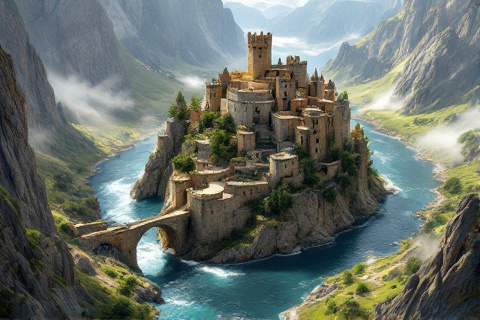
Tol Sirion: The Sentinel Isle of Beleriand
Fortress, Fiefdom, and Battleground in Tolkien's Legendarium
Geographic Location and Strategic Importance

Tol Sirion stood as a mighty island fortress in the heart of
Beleriand, rising from the rushing waters of the River
Sirion at a crucial strategic location. The island marked the vital intersection
where the Pass of Sirion threaded between the towering mountains of Ered Wethrin
to the west and the highland plateau of Dorthonion to the east, creating a
natural chokepoint in the geography of Middle-earth.
The fortress commanded the primary route between northern and southern
Beleriand, serving as a crucial checkpoint along the most important thoroughfare
in the region. This position made it an invaluable asset in controlling movement
through the realm, particularly the flow of troops, messengers, and traders
traveling between the northern marches and the southern kingdoms.
The natural defenses of Tol Sirion were formidable, with the swift-flowing River
Sirion splitting around the island's rocky shores. The powerful currents of the
river created treacherous waters that deterred attempts to approach the fortress
by water, while the elevated position of the island provided an additional layer
of natural protection against would-be assailants.
As the primary defensive position guarding the entrance to West Beleriand, Tol
Sirion served as a crucial buffer against threats from the north. The fortress
prevented hostile forces from easily accessing the protected regions of Hithlum,
Dor-lómin, and the lands beyond, making it an essential
component in the defensive strategy of the Noldorin realms.
Natural Features of the Isle
The foundation of Tol Sirion consisted of ancient bedrock that had withstood
countless ages of the river's erosion, creating steep cliffs that rose
dramatically from the water's surface. These natural stone walls provided an
imposing first line of defense and demonstrated why the Noldor
chose this location for their stronghold.
The geological composition of the island provided an ideal foundation for the
construction of fortifications, with solid rock that could support massive stone
structures. This natural advantage allowed the builders to create deep
foundations and secure anchor points for the fortress walls, ensuring the
longevity and stability of the defensive structures.
Thick stands of pine trees covered the riverbanks on both sides of Tol Sirion,
creating a natural screen that obscured movement along the shores. These forests
provided both strategic advantage for defenders and resources for the fortress,
while their roots helped prevent erosion of the riverbanks near the fortress's
bridge foundations.
The River Sirion flowed with considerable force around the island, creating a
natural moat that required no maintenance or artificial enhancement. The speed
and power of the water made it nearly impossible for enemies to cross without
using the bridges, thereby channeling any attacking force into predictable
approaches that could be more easily defended.
Architecture of Minas Tirith

The architecture of Tol Sirion exemplified the masterful craftsmanship of the
Noldor, featuring soaring white towers that gleamed in the sunlight. These
structures, built from carefully quarried and dressed stone, demonstrated the
characteristic elegance and strength of Noldorin construction techniques,
reminiscent of the towers of Tirion upon Túna in
Valinor.
The fortress walls formed an unbroken circuit around the crown of the island,
incorporating battlements and arrow slits at strategic intervals. These
defensive structures were built to exacting standards, with each stone precisely
fitted to create nearly seamless surfaces that would be difficult for attackers
to scale.
A series of watch-towers were positioned to provide comprehensive surveillance
of the Pass of Sirion and the surrounding territories. These towers were staffed
continuously and equipped with far-seeing devices of Noldorin design, allowing
guards to spot approaching threats from great distances.
The bridges of Tol Sirion were engineering marvels that connected the fortress
to both eastern and western banks of the river. These structures were designed
to be both strong enough to support heavy traffic and defensive formations, yet
could be quickly destroyed if necessary to isolate the fortress from attack.
Defensive Features
The defensive system of Tol Sirion consisted of multiple fortification layers
that extended from the riverbank to the highest point of the island. This
layered approach meant that even if attackers breached the outer defenses, they
would face increasingly difficult challenges as they attempted to progress
upward through the fortress complex.
The placement of guard towers and battlements followed a carefully planned
strategy that eliminated blind spots and created overlapping fields of fire.
This arrangement ensured that any approaching enemy would face attacks from
multiple directions, while defenders could support each other effectively during
siege conditions.
Hidden harbors and protected docks were constructed along the riverbanks,
allowing river patrol vessels to operate safely even during times of conflict.
These facilities included underwater barriers to prevent enemy boats from
approaching and secure moorings that kept patrol craft safe from the river's
strong currents.
The fortress incorporated a sophisticated network of beacons positioned to
enable rapid communication with allied strongholds throughout Beleriand. These
signal points were carefully placed to ensure clear lines of sight to other
fortresses, particularly to Minas Tirith in the west and the watchtowers of
Dorthonion to the east.
Interior Layout and Facilities
Within the main fortress of Tol Sirion, grand halls and chambers served both
defensive and ceremonial purposes. These spaces, adorned with the artistic
touches characteristic of Noldorin craftsmanship, provided areas for councils,
feasts, and the administration of the fortress's affairs while remaining
defensible in times of war.
The fortress contained extensive storage facilities and armories built to
sustain the garrison through extended periods of siege. These chambers were
carefully designed to protect supplies from moisture and pests, while remaining
easily accessible to defenders in times of need.
A complex network of underground passages honeycombed the island's bedrock,
providing escape routes and secret ways to move troops and supplies. These
tunnels were carefully engineered with ventilation shafts and drainage systems
to prevent flooding from the river.
The living quarters within Tol Sirion accommodated both the permanent garrison
and the noble residents who administered the fortress and its surrounding
territories. These areas were designed to provide comfort while maintaining
defensive capabilities, with arrow slits doubling as windows and heavily
reinforced doors protecting each section.
The Watchtower of the North

From its commanding position, Tol Sirion served as the primary observation post
for monitoring movement through the northern territories of Beleriand. Guards
maintained constant vigilance from the highest towers, watching for any signs of
enemy activity from the direction of Angband and the northern
wastes.
The fortress employed an intricate system of signal fires and warning beacons
that could be quickly activated to alert the neighboring realms of approaching
danger. This network was carefully maintained and regularly tested to ensure
messages could be relayed swiftly across vast distances.
The elevation and positioning of Tol Sirion provided unobstructed views across
the surrounding plains and to the distant mountains. This valuable vantage point
allowed defenders to monitor movement along the Pass of Sirion and across the
plains of Ard-galen to the north.
As a key point in Beleriand's defensive network, Tol Sirion played a crucial
role in coordinating military responses to threats from the north. The fortress
served as a hub for gathering and disseminating intelligence about enemy
movements, enabling the forces of the Noldor to respond quickly to invasions and
raids.
